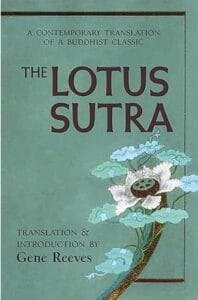A New Spirituality of Old Ideas
People from all walks of life identify with established religions. But in Western societies of the 21st century, all religions are suffering a similar fate—attendance at religious services is falling abruptly—and the trend continues. Churches, synagogues, mosques, and temples struggle to find eager participants as more and more people distance themselves from traditional religions and old ideas. In all cases, the greatest drop occurs among the younger generations, who have a declining interest in any religion, but not necessarily in spirituality.
This recent trend is nothing new, although the extent of it is. The Western religious landscape began to change rapidly during the Romantic era, a European social revolution of the early 1800s. The social activism of this time was partly a reaction against the overly materialist philosophies of the Age of Enlightenment.
Materialism cheapens human life. 102.6.10
– The Urantia Book
The intellectual and spiritual concepts associated with Romanticism led to considerable innovation in the arts and sciences, including literature, politics, and religion. It also gave rise to widespread protests against pollution, corruption, war, and church authority.
While all this was going on, renewed European military interventions in the Middle East and South Asia had the unintended consequence of introducing Eastern religions to European society. Translations of Sanskrit texts by the French scholar, Eugène Burnouf, were among the first, including an Introduction to the History of Indian Buddhism (1844) and the Buddhist text, Lotus Sutra (1852). Following on his heels was F. Max Müller, who edited a 50-volume set of translations entitled The Sacred Books of the East (1879).
In North America, the Romantic era appeared as the New Thought movement, an intellectual and spiritual trend flourishing by the latter half of the 1800s and becoming particularly popular in the early 1900s. Unlike Romanticism, this movement was overwhelmingly spiritual in nature. It borrowed ideas from Greek and Roman philosophies as well as Eastern religions, primarily from the recent European translations. Subsequently, many Hindu and Buddhist beliefs were interlaced with those of Christianity to create an age of syncretistic spiritualism, one manifesting in many forms.
Adherents of New Thought teachings embraced ideals of God as Infinite Intelligence, and spirit as Ultimate Reality—concepts borrowed directly from Brahmanism, an ancient religion of India. But the range of ideas varied widely. Some writers dealt explicitly with Eastern ideals while others integrated Greek metaphysics or the teachings of Jesus. Some saw God writ large in the universe, while others were atheistic.
The New Thought movement had a tremendous effect on Western spiritualism and religious culture, transforming both Eastern spiritual traditions as well as those of mainstream Christianity. Some prominent contributors of the time include Prentice Mulford, James Allen, Ralph Waldo Emerson, William James, Napoleon Hill, Joseph Murphy, A. K. Mozumdar, Ernest Holmes, and the prolific William W. Atkinson.
Although there were some questionable practices and dubious concepts associated with New Thought, the positive effects of this unique spiritual resurgence included a wealth of new literature and a fresh consideration of Christian teachings, as well as significant and beneficial changes in the study of sociology, psychology, and the humanities.
The ideas embraced in the New Thought era receded during the world wars but enjoyed a notable resurgence during the counterculture movement of the 1960s, when many young people again shunned traditional Christian thought and began to explore alternative religions, especially Eastern ones.
Indeed, the cultural revolutionaries of that time explored and resuscitated almost anything thought to be associated with the supernatural, including ancient practices such as astrology, crystals, Tarot cards, and the I Ching. This was the beginning of so-called New Age spirituality.
New Thought Becomes New Age
Many ideas prevalent in New Age spiritualism can be traced to the New Thought era, which, in turn, was greatly influenced by Greek and Indian philosophies. Overall, New Age thought and practices were heavily eclectic, drawing from a wide array of spiritual beliefs.
But when it comes to ideas about God, divinity, or spirituality, New Age thinking was, and still is, dominated by Hindu and Buddhist notions of consciousness, mindfulness, meditation, and enlightenment, as well as moral and philosophical concepts outlining the goals and duties of a religious life. But as we dig a little deeper, we see that both of these religions were themselves constructed on an even earlier foundation of Brahman ideals.
Brahman philosophy has its roots in the ancient Vedic beliefs of northern India, a tradition founded by at least 1500 BC. The Rishis (sages) of the Vedas portray Brahman as the Ultimate Reality without beginning or end—the Supreme Being who is the prime cause and creator of all reality. This entity is also believed to exist outside reality and is so powerful that the human mind cannot comprehend it. Another idea stemming from Brahmanism is the concept of a Supreme Soul (Atman) from which all other human souls derive. This soul (or self) is believed to be a divine spark carried within everyone as a means to commune with Brahman.1
In many ways, Brahman beliefs correspond with Judeo-Christian ideas, wherein God is the creator of the universe; the source and cause of all reality. Also similar is the idea that the Spirit of God (Atman) dwells within every person—the kingdom of heaven within—a divine spark that is a part of the very same Divine Source.
Although advanced in metaphysical concept, the weakness of Brahmanism is that it has little appeal to many struggling souls, simply because it lacks any personal intimacy. Brahmanism promotes the existence of an Absolute Being, which God is. But this infinite Being is a nonpersonal God, one that seems distant, indifferent, and unreachable to most. It’s a God devoid of compassion, understanding, or love, thereby depriving its followers of having a personal relationship with a personal God—the experience of true personal communion with the very Source of personality—the First Person.
Even an anthropomorphic Yahweh is of greater religious value than an infinitely remote Absolute of Buddhism or Brahmanism. 94.11.12
– The Urantia Book
Brahman metaphysics had a strong influence on Eastern religions, and much of its philosophy figures prominently in current religious and spiritual thought, giving rise to reworked practices and ideas, including modified forms of yoga and post-colonial notions of chakras (body focal points), atman (soul), and moksha (enlightenment).
Siddhartha Gautama, the founder of Buddhism and a contemporary of Lao Tzu and Confucius, was frustrated with the many human-like gods of India. In his concerted effort to eliminate the worship of these anthropomorphic gods, he rejected all gods, including Brahman as the Universal Creator and First Cause. He also rejected any concept of ultimate reality or universal intellect, and dismissed the Brahman belief in a Supreme Soul and all ideas about reincarnation or divine beings.2

But despite Siddhartha’s rejections, traditional Hindu beliefs and Brahman ideology were so firmly embedded in Indian culture that later Buddhist sects reintroduced these long-cherished ideas in various forms; notions they later attributed to Buddha, just as early Christian leaders attributed some of their individual beliefs to the teachings of Jesus.
Siddhartha was progressive. He greatly enhanced and enlightened the spiritual thought of his day by discarding many of the crude practices and rituals so prevalent at the time. He did his best to teach as a messenger of God and yet, with some inconsistency, he rejected any notion of a personal, creative God or any other spirit being with whom one could commune. And today, this inclination to discount the existence of a personal and communicable God deeply permeates almost every branch of Buddhism and much of New Age spiritualism.
He [Buddha] tried to live and teach as a messenger of God, but without God. 132.7.4
– The Urantia Book
Humanistic Religion
Siddhartha’s nontheistic approach and his rejection of a Supreme Soul as well as an ultimate Source of reality, left his followers with few spiritual alternatives and little motivation for authentic contact with either a divine Creator or spirit personalities. Subsequently, some branches of Buddhism have become merely philosophical—an exalted humanism. Even the words of the current Dalai Lama reflect this philosophy: “The most important thing is to be a good human being… Whether you believe in God or not does not matter so much, whether you believe in Buddha or not does not matter so much…” (Kindness, Clarity, and Insight, 2013)
Without a doubt, it is important for all of us to be good human beings. It is also understandable that humanist inclinations are widely popular among Buddhists and most New Age followers, if not society at large. Humanism, while changed over the years, is a well-intentioned philosophy that focuses on human welfare, advocates freedom and progress, and has faith in science and reason, all of which are highly commendable and desirable sentiments.
But humanism also rejects religion, revelation, and the supernatural as potential sources of change, although this was not always the case. Before the growing conflict between science and religion in the 18th century, God remained as creator and supreme authority. But as the rebellion against church authority gained ground, humanists eventually rejected all religion in favor of human agency, thereby creating a scientific or secular humanism.
At the time, this was a reasonable reaction to the oppressive power of the church and its intractable dogma. It was a way of taking responsibility for human progress out of the hands of religious organizations and putting things squarely in the hands of humanity by asserting that such things as civilization, ethics, morals, and compassion are human obligations, not religious ones.
Overall, humanism is an advanced humanitarian philosophy, if not a secular religion in its own right. In general, I agree with most of its ideas and ideals, except for its rejection of God and spiritual powers as potential sources of positive change and moral direction.
Religion is only an exalted humanism until it is made divine by the discovery of the reality of the presence of God in personal experience. 195.10.1
– The Urantia Book

The premise of humanism is that there exists an innate, yet inexplicable, sense of goodness in humanity and, contentiously, that each person can decide for themselves what is good. It is a laissez-faire philosophy claiming that all values and morals are derived from human experience and culture.
Humanism is an appealing philosophy in a materialistic age—but it is just another theory—one that does not explain why some people are not good. An alternative theory is that the ultimate source of moral direction is not genetically inherent in the human brain but instead is explained by the living Spirit existing within all of us—the source of all divine values—the Divine Value Giver. And good people are those who accept and embrace these divine values.
The God experience rests on our belief and faith in the goodness and wisdom of God—that God does matter—that faith in God’s guidance not only makes us good human beings, but also re-creates us as spirit-born individuals. This transforming experience is appreciably more than simply “believing in God”—it is knowing and trusting the loving, helpful, and compassionate Source of all existence.
In its true essence, religion is a faith-trust in the goodness of God. 2.6.1
– The Urantia Book
Nevertheless, the humanist trend in Buddhism, along with its indifference to God (or at least the Judeo-Christian idea of God), was a welcome relief for many New Thought spiritualists who were increasingly uncomfortable with Christian authority and doctrine, particularly the Old Testament portrayal of God as a pugnacious bully, as Walt Whitman pointed out.
In an age of enlightenment, many intellectuals found it difficult to reconcile their newfound ideas with the illogical and unreasonable teachings of Christianity, such as the belief that God, as a loving, good, and merciful Father to all humanity, requires penance, sacrifice, or the ritualistic shedding of blood to win his favor or atone for sins.
What eventually grew out of the New Thought era and continued into New Age philosophy, was an inclination to view spirituality as a science of the mind. And perhaps the most influential author in this regard was Ernest Holmes (The Science of Mind, 1922). At first glance, this seemed like a reasoned approach, and a welcome one when it came to an honest assessment of current religious beliefs.
But the “science of mind” philosophy as defined by Holmes did not reject God or spirituality. In fact, he openly professed to believe in “the Universal Spirit, which is God.” Despite his assertion, many contemporary practitioners misinterpret the science of mind approach for pure science or social science, when it is actually metaphysics with a dash of psychology.
As a result of these recent attempts to align with science and perhaps gain some credibility, the spiritual tone of Western Buddhism became increasingly secular and, instead of a religion or spiritual quest, became better known for its meditation and mindfulness techniques, ones developed for the express purpose of attaining inner peace and wisdom.
While some Western Buddhists wish to appear more rational by explicitly putting aside God and spirituality, more transcendent devotees of Buddhism maintain their religion is a purely spiritual tradition, putting an emphasis on spiritual growth and spiritual insight (nirvana and bodhi mind). It is a tradition with a strong moral component, teaches compassion, and has an ultimate goal of wisdom, all of which are supernatural and spiritual pursuits.
Just as a candle cannot burn without fire, men cannot live without a spiritual life.
– Buddha
Pantheism Revival
Pantheism—the idea that God is everything—views God as a spiritual force or divine essence that either permeates or encompasses the universe, even as infinite mind. In some beliefs, pantheism is the view that the universe and God are one, an idea reflected in Hinduism and Taoism, although similar concepts appeared independently in ancient Greek philosophies.

Through the influence of Brahmanism, some Eastern religions promoted the idea that the original entity first revered as Ultimate Reality, is actually little more than the physical universe and its energy systems. This is one belief of the Jain religion, which, like Buddhism, rejects any notion of a creator God, believing instead that the universe and all things always existed (see The Original Source).
Pantheism was an understandable evolution in religious thought because so much of religion, past and present, East and West, was dominated by crude concepts of anthropomorphic gods fraught with human frailties.
In these early religions, it was assumed that, if God were a person, he would have to have a body limited to space and time and subject to human characteristics. Pantheism was a reasonable reaction against this kind of thinking. It was an attempt to strip away anthropomorphic gods by equating God with the universe but, in the process, it also stripped away any notion of a personal God.
For neither is God a being with the form of a man, nor is the human body like the form of God.
– Philo of Alexandria
What advocates of pantheism failed to understand is that God could be personal without being human. Consequently, pantheism evolved as a philosophy that not only rejects a personal God but also dismisses any concept of a supreme creator. Rather than seeing the universe as an act of creation, the universe is God.
The implication, similar to Jain beliefs, is that the universe is eternal and self-existent, and that consciousness, or mind, is naturally inherent in energy and matter. Such beliefs are a form of animism, wherein consciousness or spirit is attributed to inanimate objects, such as rocks, trees, or the physical universe.
Much later, among European academics, pantheism was popularized by the 17th century philosopher, Baruch Spinoza, who subsequently influenced the thoughts of generations of philosophers and scientists, including Albert Einstein and Carl Sagan. But to be fair to Spinoza, he did not claim to identify God with any manifestations of nature, not even the universe.
Later on, philosophers and spiritualists, reluctant to dismiss any notion of a creator God, but faced with Spinoza’s reasoning, developed a new pantheism, one that encompassed more traditional notions of God. Guided by Brahman and Christian ideals, they portrayed the cosmos as an all-powerful, all-present, all-loving, and all-wise entity. But once again, God was stripped of personality. The Eternal Source remained as some-thing rather than some-one.
In materialism, since man loses his body at death, he ceases to exist as a personality; in pantheism, since God has no body, he is not, therefore, a person. 1.5.12
– The Urantia Book
The New Thought movement was fond of pantheistic ideas, as we see in the writings of Prentice Mulford, Walt Whitman, and Ralph Waldo Emerson, among others. Like many people of this era, New Age spiritualists were reluctant to adopt the Judeo-Christian image of a personal and communicative God, preferring to believe that a spiritual experience was the act of tapping into the energy, power, or spiritual essence of the cosmos.
Nature Religions
In addition to Indian and Greek religious cosmologies, holistic notions of divinity are also popular at the present time. Holism is the philosophical view that all life and everything in the universe are connected, interactive, and unified in nature. This is one premise of Gaia philosophy, a belief that the planet and all life function as a single, self-regulating system in which life supports life.
There is also a relatively recent resurgence of pagan and neopagan religions, such as Wicca and other ancient Celtic practices, much of which was popularized by Gerald Gardner (Witchcraft Today, 1954). Since his time, many traditions evolved within Wicca itself, mixing Celtic beliefs with some ideas derived from Greek and Indian philosophies.
Similar to some New Age beliefs and practices, Wicca philosophy embraces concepts of pantheism as well as a revival of polytheism. In vogue, is the portrayal of a universe equally dominated by male and female deities, often revived as nature deities or, on a grander scale, as a Mother Goddess who stands either alongside, or as a replacement for, a Father God. But in its original form, both gods were believed to be overseen by a genderless Supreme Deity, also described as the Prime Mover or the Supreme Cosmic Power.
Overall, we can see that most spiritual practices today have their origins in ancient religions. And the same applies for many of our religious concepts, which leads us to conclude there is little difference between spirituality and religion.
Religion is destined to become the reality of the spiritual unification of all that is good, beautiful, and true in human experience. 5.4.7
– The Urantia Book
For more discussion on the important points of religion and spirituality, see The Trouble with Old Religion.
Footnotes





